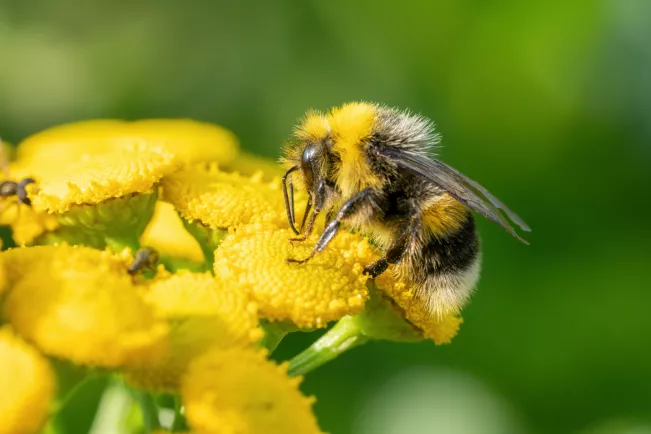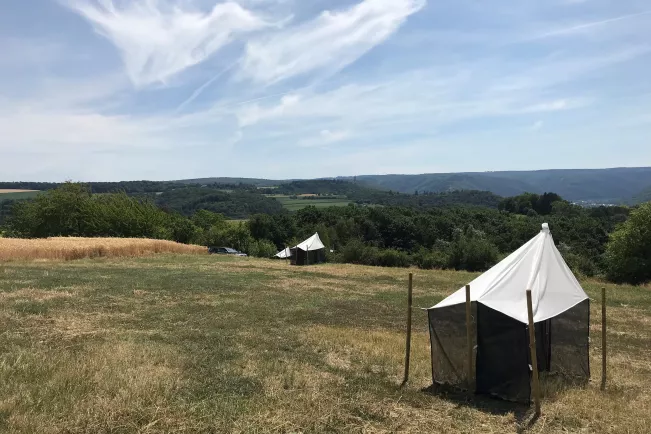Communications and Marketing
H-BRS scientists research insect diversity in nature reserves - focus on stakeholders

Nature reserves are one of the most important instruments for preserving biodiversity. However, they can hardly fulfil these functions, or only to a limited extent, if they are exposed to negative environmental influences. In the joint research project DINA (Diversity of Insects in Nature Conservation Areas), eight project partners investigated the effectiveness of protected areas that border on agriculturally used land. In the process, the diversity of insects was recorded at 21 sites in Germany, the vegetation from the edge to the core of the protected area as well as soil samples and much more were analysed. The data shed light on the causes of the loss of insect diversity.
"Our socio-ecological surveys revealed that the need for insect conservation is generally accepted. The framework conditions are crucial: farmers, as the main stakeholders, are pushing for more appreciation and planning security as well as adequate support and flexibility to implement biodiversity-promoting measures," says Professor Wiltrud Terlau from Bonn-Rhein-Sieg University of Applied Sciences. "For conservation measures to really be implemented, the acceptance of all stakeholders from agriculture, landscape management, nature conservation, politics and civil society is required. The analysis methods and dialogue formats that our project partners and we have developed in the DINA project can be transferred to other nature conservation areas in Germany," the director of the International Centre for Sustainable Development (IZNE) at the university continues.

The results of the interdisciplinary research project funded by the Federal Ministry of Education and Research (BMBF) are now available. One central finding is that even in nature reserves, the loss of biodiversity and habitats continues unabated. Because: Protected areas contain and are surrounded by arable land - even with conventional use. Insects in nature reserves fly to a far greater extent than previously assumed to forage on crops, so that adjacent farmland has a detrimental effect on the occurrence of endangered species on the periphery of the protected habitats.
Together with Angela Turck, a research associate at the IZNE, the scientist used social science methods to research the perspectives of the farmers in particular, who were identified as the main stakeholders. In a multi-stage process, the IZNE first used questionnaires to identify the challenges and needs of farmers in the selected project areas. In the further course, interviews and focus group discussions were conducted with farmers. The Bonn-based opinion research institute dimap conducted these on behalf of the project. The research was accompanied by interviews with other stakeholders in order to gain a greater diversity of perspectives and insights into the heterogeneity of stakeholders' views. In discussions with the farmers, the researchers discussed questions about existing and possible compensation for efforts, financial incentives, the demands and requirements of the different actors and the motivation to protect insects. Finally, in a participatory workshop, the university worked out recommendations for action together with the most diverse interest groups in order to make the diverse concerns around a nature reserve work together in the interest of biodiversity.
"Insect conservation, and thus also biodiversity conservation, should be recognised as a public service where the costs are not borne by the main stakeholders alone. Society as a whole benefits from biodiversity conservation as it provides important ecosystem services. It is therefore justified that these costs are also borne by society, for example through targeted support programmes," says scientist Angela Turck.
The scientific institutions of the DINA project have derived four central recommendations for the effective protection of insect diversity from their joint research work. For example, they advocate taking greater account of the surrounding agricultural land of protected areas in landscape planning. Biodiversity and environmental monitoring should be expanded and the framework conditions for insect conservation improved. They emphasise the need for participation and acceptance by all stakeholders.
The project: Diversity of insects in nature conservation areas
Accompanying surveys and focus group discussions with farmers as main stakeholders were conducted to investigate the framework conditions for the acceptance of insect conservation measures. In addition, in-depth dialogue workshops were held at three DINA sites with stakeholders from nature conservation, agriculture and other interest groups. The Federal Ministry of Education and Research (BMBF) funded the project with a total of 4.6 million euros. NABU was responsible for project coordination.
The following institutions collaborated in the DINA research project:
• Entomologischer Verein Krefeld (EVK)
• iES Landau, Institut für Umweltwissenschaften Landau / Universität Koblenz-Landau
• Internationales Zentrum für Nachhaltige Entwicklung / Hochschule Bonn-Rhein-Sieg (IZNE)
• Leibniz-Institut für ökologische Raumentwicklung (IÖR)
• Leibniz-Institut zur Analyse des Biodiversitätswandels (LIB) / Zoologisches Forschungsmuseum Alexander Koenig (ZFMK)
• ISOE – Institut für sozial-ökologische Forschung
• NABU – Naturschutzbund Deutschland, mit TIEM – Integrierte Umweltüberwachung
• Uni Kassel (UniKS)
Kontakt

Wiltrud Terlau
Professor of Economics, Resilient and Sustainable Development, Director of the International Centre for Sustainable Development (IZNE), Department of Economics
Research fields
Location
Rheinbach
Room
B 111
Address
von-Liebig-Straße 20
53359, Rheinbach
Telephone
+49 2241 865 410Location
Sankt Augustin
Room
Raum F 305
Address
Grantham-Allee 20,
53757, Sankt Augustin

Angela Turck
Research associate 'Responsible Economy and Natural Resources', Ph.D. student
Location
Sankt Augustin
Room
F 308
Address
Grantham-Allee 20
53757, Sankt Augustin
Telephone
+49 2241 865 9788
Location
Sankt Augustin
Room
E 240
Address
Grantham-Allee 20
53757, Sankt Augustin
Telephone
+49 2241 865 9560